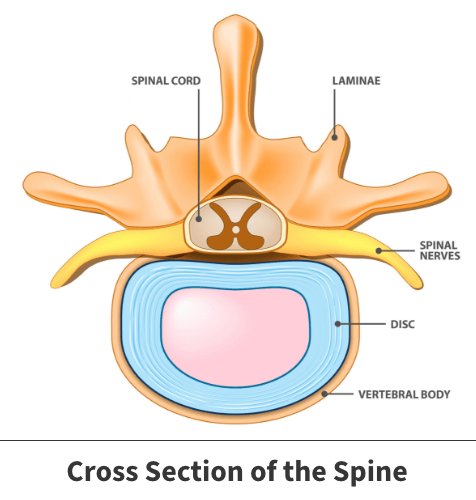Laminectomy: decompression surgery
The spine is one of your body’s most essential parts. Without it, you could not move, stand, walk, or carry out other basic movements. The nerves inside your spine also influence how other vital bodily systems function.
All spinal injuries need to be addressed immediately and can be very concerning. Some incidences impact the spinal components known as laminas.
Anatomy

Laminas are flat, arch-shaped structures located near the back part of the vertebra – a collection of bones forming your backbone. Laminas also make up a part of your spinal canal.
About
When laminas age, grow irritated, are affected by illness, or sustain any injury, a condition known as spinal compression can occur. Relief from pain is possible through a procedure called laminectomy (spinal decompression surgery).
Causes of spinal compression
Many conditions can compress or push against the spinal nerves, muscles, and soft tissues, including:
- Inflammatory diseases like arthritis and spondylosis
- Disc problems like degeneration and herniation
- Sciatica
- Benign spinal tumors
- A narrowing of the spinal canal known medically as spinal stenosis
Bone spurs are the most significant reason spinal compression occurs, and a laminectomy is often performed to correct it. Spurs are overgrown bones that extend into the spinal canal. This condition is often a side effect of arthritis or old age.
Symptoms
Specific symptoms will depend on the exact underlying problem. Compression illnesses can produce common symptoms like numbness, weakness, and pain in the back, legs, and arms. In more advanced cases, your mobility can be affected.
Solid candidates for decompression surgery
Your surgeon might recommend the procedure if:
- Conventional treatment methods did not work – In the early and uncomplicated stages of many spinal compression issues, doctors will first prescribe more conventional treatment options like pain medications and physical therapy. Should these options not ease your symptoms or the underlying problem worsens, you may be a candidate for laminectomy.
- Mobility issues arise – Compression could become severe enough to interfere with your ability to walk or possibly even stand up. If this is the case, decompression surgery is a viable option.
- Systemic bodily concerns emerge – Spinal nerves can impact bowel or bladder functions. When compression is severe, the nerves controlling urination or defecation can become so damaged that you cannot manage them. These signs are indications that you may need to undergo a laminectomy.
- Herniated discs are present – In certain instances, laminas are removed to enable orthopedic surgeons to access herniated discs.
Complications
If your spinal compression is not correctly addressed, the underlying condition may only worsen. Eventually, this could result in increased pain, disability, and paralysis in the most severe occurrences.

Diagnosis
Your doctor will identify specific spinal compression illnesses and determine your need for decompression surgery using MRIs, CT scans, or X-rays. These diagnostic tools capture images of your spine and enable doctors to diagnose an exact cause and gauge its severity.
Treatment
During a laminectomy, surgeons remove damaged or diseased lamina. There are three specific types of laminectomies:
- Cervical (neck)
- Thoracic (middle back region)
- Lumbar (lower back)
Surgeons begin the procedure by making an incision over the area. Before reaching the affected lamina, your doctor might need to push away the surrounding muscles. Then, small surgical tools are used to collect and extract the lamina. When the laminas are being removed during herniated disc surgery, the damaged disc is typically also removed.
Vacated lamina is usually not replaced by any synthetic material. This is because enough bone and muscle still protect the spinal cord.
Recovery
A brief stay in the hospital usually follows surgery. Typically, you will likely need physical therapy once healing has progressed sufficiently. These are individually designed exercises geared towards helping your improving spine and surrounding regions regain any lost strength or mobility.
Learn More About Physical Therapy
You might be able to return to work in as little as a few weeks after the procedure, contingent upon how physically demanding your work is.
Intended benefits
A significant percentage of laminectomy patients experience less pain and increased mobility.
Videos
Related specialties
- Anterior Cervical Corpectomy & Discectomy
- Artificial Disc Replacement (ADR)
- Bone Cement Injection
- Degenerative Disc Disease
- Diffuse Idiopathic Skeletal Hyperostosis (DISH)
- Discectomy
- Discitis Treatment & Information
- Epidural Injections for Spinal Pain
- Foraminotomy
- Interlaminar Implants
- Interlaminar Lumbar Instrumental Fusion: ILIF
- Kyphoplasty (Balloon Vertebroplasty)
- Kyphosis
- Lumbar Epidural Steroid Injection
- Lumbar Interbody Fusion (IBF)
- Minimally Invasive Spine Surgery
- Outpatient Spine Surgery
- Pinched Nerve
- Piriformis Syndrome
- Sacroiliac Joint Pain
- Sciatica
- Scoliosis
- Spinal Fusion
- Spondylolisthesis & Spondylolysis
- Vertebroplasty
- Whiplash & Whiplash Associated Disorder (WAD)
